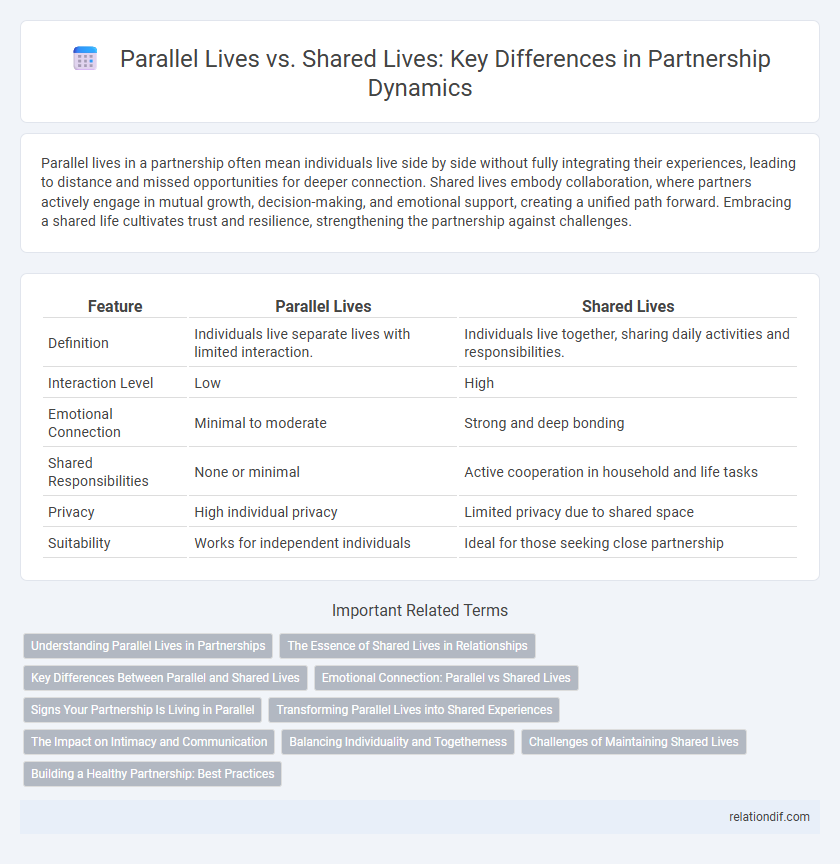Parallel lives in a partnership often mean individuals live side by side without fully integrating their experiences, leading to distance and missed opportunities for deeper connection. Shared lives embody collaboration, where partners actively engage in mutual growth, decision-making, and emotional support, creating a unified path forward. Embracing a shared life cultivates trust and resilience, strengthening the partnership against challenges.
Table of Comparison
| Feature | Parallel Lives | Shared Lives |
|---|---|---|
| Definition | Individuals live separate lives with limited interaction. | Individuals live together, sharing daily activities and responsibilities. |
| Interaction Level | Low | High |
| Emotional Connection | Minimal to moderate | Strong and deep bonding |
| Shared Responsibilities | None or minimal | Active cooperation in household and life tasks |
| Privacy | High individual privacy | Limited privacy due to shared space |
| Suitability | Works for independent individuals | Ideal for those seeking close partnership |
Understanding Parallel Lives in Partnerships
Parallel lives in partnerships refer to partners leading largely independent existences with minimal emotional or practical overlap, maintaining separate social circles, interests, and routines. This dynamic can create personal space and autonomy but may limit the intimacy and mutual support typically found in shared lives, where partners integrate activities, goals, and emotional experiences. Understanding parallel lives helps partners navigate boundaries and expectations, ensuring respect for individuality while fostering connection when desired.
The Essence of Shared Lives in Relationships
Shared lives in relationships center on mutual growth and emotional intimacy, where partners integrate their goals, values, and experiences into a cohesive bond. Unlike parallel lives, where individuals coexist with limited overlap, shared lives emphasize collaboration, deep communication, and joint decision-making. This interconnectedness fosters resilience, trust, and a profound sense of unity that defines enduring partnerships.
Key Differences Between Parallel and Shared Lives
Parallel lives in partnerships involve partners maintaining separate routines, interests, and social circles, prioritizing individual autonomy and personal space. Shared lives emphasize joint activities, mutual decision-making, and interdependent lifestyles, fostering deeper emotional connection and collaboration. Recognizing these key differences helps couples balance independence and togetherness to suit their relationship dynamics.
Emotional Connection: Parallel vs Shared Lives
Emotional connection in parallel lives often involves maintaining individual experiences and emotions, allowing partners to support each other while preserving personal space. In shared lives, emotional bonds are deeply intertwined, fostering mutual understanding and joint participation in daily activities and feelings. The strength of a partnership depends on balancing independence with emotional intimacy to meet both partners' needs effectively.
Signs Your Partnership Is Living in Parallel
Signs your partnership is living in parallel include frequent emotional distance despite physical proximity, where partners engage separately rather than share experiences. Communication often becomes transactional, lacking depth and emotional connection, leading to feelings of isolation. Each person prioritizes individual goals over joint growth, reflecting a lack of shared vision essential for a thriving partnership.
Transforming Parallel Lives into Shared Experiences
Transforming parallel lives into shared experiences enhances relationship depth and mutual understanding. Couples who actively integrate their daily routines and goals foster stronger emotional connections and sustained growth. Shared experiences create a foundation for collaborative problem-solving and increased empathy in partnerships.
The Impact on Intimacy and Communication
Parallel lives in a partnership often lead to emotional distance and decreased communication, as partners prioritize individual experiences over shared moments. Shared lives foster deeper intimacy through consistent interaction, mutual support, and aligned goals, strengthening emotional bonds. Effective communication thrives in shared lives, enabling partners to navigate challenges collaboratively and build trust over time.
Balancing Individuality and Togetherness
Balancing individuality and togetherness in a partnership requires recognizing the value of both parallel lives and shared experiences. Maintaining personal interests and goals fosters self-growth, while cultivating shared activities strengthens emotional bonds and mutual understanding. Striking this balance enhances relationship satisfaction by allowing partners to thrive independently and collaboratively.
Challenges of Maintaining Shared Lives
Maintaining shared lives in a partnership presents challenges such as balancing individual identities with collective goals and navigating conflicts that arise from differing perspectives. Effective communication and mutual respect are essential to address issues related to trust, boundaries, and emotional needs. Overcoming these hurdles requires continuous effort to foster understanding and alignment within the shared life framework.
Building a Healthy Partnership: Best Practices
Building a healthy partnership requires balancing personal growth with shared goals, emphasizing open communication and mutual respect to foster trust. Establishing clear boundaries while engaging in joint decision-making enhances harmony between parallel lives and shared lives. Regular reflection on individual needs alongside partnership dynamics supports sustainable, resilient relationships.
Parallel Lives vs Shared Lives Infographic

 relationdif.com
relationdif.com